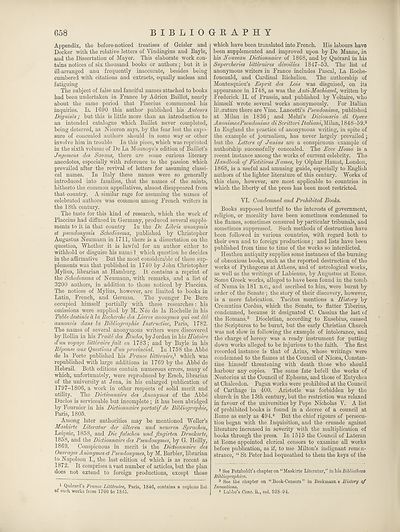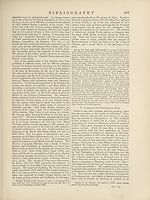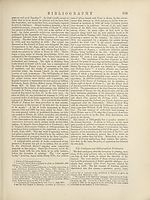Encyclopaedia Britannica > Volume 3, Athens-BOI
(670) Page 658
Download files
Complete book:
Individual page:
Thumbnail gallery: Grid view | List view

BIBLIOGRAPHY
658
Appendix, the before-noticed treatises of Geisler and
Decker with the relative letters of Yindingius and Bayle,
and the Dissertation of Mayer. This elaborate work con¬
tains notices of six thousand books or authors; but it is
ill-arranged ana frequently inaccurate, besides being
cumbered with citations and extracts, equally useless and
fatiguing
The subject of false and fanciful names attached to books
had been undertaken in France by Adrien Baillet, nearly
about the same period that Placcius commenced his
inquiries. In 1G90 this author published his Auteurs
Deguises; but this is little more than an introduction to
an intended catalogue which Baillet never completed,
being deterred, as Niceron says, by the fear lest the expo¬
sure of concealed authors should in some way or other
involve him in trouble In this piece, which was reprinted
in the sixth volume of De La Monnoye’s edition of Baillet’s
Jugemens des Savans, there are some curious literary
anecdotes, especially with reference to the passion which
prevailed after the revival of letters for assuming classi¬
cal names. In Italy these names were so generally
introduced into families, that the names of the saints,
hitherto the common appellatives, almost disappeared from
that country. A similar rage for assuming the names of
celebrated authors was common among French writers in
the 18th century.
The taste for this kind of research, which the work of
Placcius had diffused in Germany, produced several supple¬
ments to it in that country In the De Libris anonymis
et pseudonymis Sckediasma, published by Christopher
Augustus Neumann in 1711, there is a dissertation on the
question, Whether it is lawful for an author either to
withhold or disguise his name 1 which question he decides
in the affirmative But the most considerable of these sup¬
plements was that published in 1740 by John Christopher
Mylius, librarian at Hamburg. It contains a reprint of
the Schediasma of Neumann, with remarks, - and a list of
3200 authors, in addition to those noticed by Placcius.
The notices of Mylius, however, are limited to books in
Latin, French, and German. The younger De Bure
occupied himself partially with these researches: his
omissions were supplied by M. N6e de la Bochelle in his
Table destinee ct la Recherche des Livres anonymes qui out ete
annonces dans la Bibliographie Instructive, Paris, 1782.
The names of several anonymous writers were discovered
by Rollin in his Traite des Etudes, by Jordan in his Histoire
d’un voyage litteraire fait en 1783; and by Bayle in his
Reponse aux Questions d’un provincial. In 1758 the Abbe
de la Porte published his France litterairef which was
republished with large additions in 1769 by the Abb6 de
Hebrail. Both editions contain numerous errors, many of
which, unfortunately, were reproduced by Ersch, librarian
of the university at Jena, in his enlarged publication of
1797-1806, a work in other respects of solid merit and
utility. The Dictionnaire des Anonymes of the Abb6
Duclos is serviceable but incomplete ; it has been abridged
by Fournier in his Dictionnaire portatif de Bibliographie,
Paris, 1805.
Among later authorities may be mentioned Weller’s
MasTcirte Literatur der dlteren und neueren Sprachen,
Leipsic, 1858, and Die falschen und fingirten Druchorte,
1858, and the Dictionnaire des Pseudonymes, by G. Heilly,
1869. Conspicuous in merit is the Dictionnaire des
Ouvrages Anonymes et Pseudonymes, by M. Barbier, librarian
to Napoleon I., the last edition of which is as recent as
1872. It comprises a vast number of articles, but the plan
does not extend to foreign productions, except those
1 Querard’s France Litteraire, Paris, 1846, contains a copious list
of such works from 1700 to 1845.
which have been translated into French. His labours have
been supplemented and improved upon by De Manne, in
his Nouveau Dictionnaire of 1868, and by Querard in his
Supercheries litteraires devoilees 1847-53. The list of
anonymous writers in France includes Pascal, La Pioche-
foucauld, and Cardinal Richelieu. The authorship of
Montesquieu’s Esprit des Lois was disguised, on its
appearance in 1748, as was the Anti-Machiavel, written by
Frederick II. of Prussia, and published by Voltaire, who
himself wrote several works anonymously. For Italian
literature there are Vine. Lancetti’s Pseudonima, published
at Milan in 1836; and Melzi’s Dizionario di Opere
Anonime-ePseudonime di Scrittori Italiani, Milan, 1848-59.1 2
In England the practice of anonymous writing, in spite of
the example of journalism, has never largely prevailed;
but the Letters of Junius are a conspicuous example of
authorship successfully concealed. The Ecce Homo is a
recent instance among the works of current celebrity. The
Handbook of Fictitious Names, by Olphar Hamst, London,
1868, is a useful and amusing guide, especially to English
authors of the lighter literature of this century. Works of
this class, however, are most applicable to countries in
which the liberty of the press has been most restricted.
VI. Condemned and Prohibited Books.
Books supposed hurtful to the interests of government,
religion, or morality have been sometimes condemned to
the flames, sometimes censured by particular tribunals, and
sometimes suppressed. Such methods of destruction have
been followed in various countries, with regard both to
their own and to foreign productions; and lists have been
published from time to time of the works so interdicted.
Heathen antiquity supplies some instances of the burning
of obnoxious books, such as the reported destruction of the
works of Pythagoras at Athens, and of astrological works,
as well as the writings of Labienus, by Augustus at Rome.
Some Greek works, alleged to have been found in the tomb
of Numa in 181 B.C., and ascribed to him, were burnt by
order of the Senate; the story of their discovery, however,
is a mere fabrication. Tacitus mentions a History by
Cremutius Cordus, which the Senate, to flatter Tiberius,
condemned, because it designated C. Cassius the last of
the Romans.3 Diocletian, according to Eusebius, caused
the Scriptures to be burnt, but the early Christian Church
was not slow in following the example of intolerance, and
the charge of heresy was a ready instrument for putting
down works alleged to be injurious to the faith. The first
recorded instance is that of Arius, whose writings were
condemned to the flames at the Council of Nicaea, Constan¬
tine himself threatening with death those who should
harbour any copies. The same fate befell the works of
Nestorius at the Council of Ephesus, and those of Eutyches
at Chalcedon. Pagan works were prohibited at the Council
of Carthage in 400. Aristotle was forbidden by the
church in the 13th century, but the restriction was relaxed
in favour of the universities by Pope Nicholas V. A list
of prohibited books is found in a decree of a council at
Rome as early as 494.4 But the chief rigours of persecu¬
tion began with the Inquisition, and the crusade against
literature increased in severity with the multiplication of
books through the press. In 1515 the Council of Lateran
at Rome appointed clerical censors to examine all works
before publication, as if, to use Milton’s indignant remon¬
strance, “ St Peter had bequeathed to them the keys of the
2 See Petzholdt’s chapter on “Maskirte Literatur,” in his Bibliotheca.
Bibliographica.
3 See the chapter on “Book-Censors” in Beckmanns History of
Inventions.
4 Labbe’s Cone, ii., col. 938-94.
658
Appendix, the before-noticed treatises of Geisler and
Decker with the relative letters of Yindingius and Bayle,
and the Dissertation of Mayer. This elaborate work con¬
tains notices of six thousand books or authors; but it is
ill-arranged ana frequently inaccurate, besides being
cumbered with citations and extracts, equally useless and
fatiguing
The subject of false and fanciful names attached to books
had been undertaken in France by Adrien Baillet, nearly
about the same period that Placcius commenced his
inquiries. In 1G90 this author published his Auteurs
Deguises; but this is little more than an introduction to
an intended catalogue which Baillet never completed,
being deterred, as Niceron says, by the fear lest the expo¬
sure of concealed authors should in some way or other
involve him in trouble In this piece, which was reprinted
in the sixth volume of De La Monnoye’s edition of Baillet’s
Jugemens des Savans, there are some curious literary
anecdotes, especially with reference to the passion which
prevailed after the revival of letters for assuming classi¬
cal names. In Italy these names were so generally
introduced into families, that the names of the saints,
hitherto the common appellatives, almost disappeared from
that country. A similar rage for assuming the names of
celebrated authors was common among French writers in
the 18th century.
The taste for this kind of research, which the work of
Placcius had diffused in Germany, produced several supple¬
ments to it in that country In the De Libris anonymis
et pseudonymis Sckediasma, published by Christopher
Augustus Neumann in 1711, there is a dissertation on the
question, Whether it is lawful for an author either to
withhold or disguise his name 1 which question he decides
in the affirmative But the most considerable of these sup¬
plements was that published in 1740 by John Christopher
Mylius, librarian at Hamburg. It contains a reprint of
the Schediasma of Neumann, with remarks, - and a list of
3200 authors, in addition to those noticed by Placcius.
The notices of Mylius, however, are limited to books in
Latin, French, and German. The younger De Bure
occupied himself partially with these researches: his
omissions were supplied by M. N6e de la Bochelle in his
Table destinee ct la Recherche des Livres anonymes qui out ete
annonces dans la Bibliographie Instructive, Paris, 1782.
The names of several anonymous writers were discovered
by Rollin in his Traite des Etudes, by Jordan in his Histoire
d’un voyage litteraire fait en 1783; and by Bayle in his
Reponse aux Questions d’un provincial. In 1758 the Abbe
de la Porte published his France litterairef which was
republished with large additions in 1769 by the Abb6 de
Hebrail. Both editions contain numerous errors, many of
which, unfortunately, were reproduced by Ersch, librarian
of the university at Jena, in his enlarged publication of
1797-1806, a work in other respects of solid merit and
utility. The Dictionnaire des Anonymes of the Abb6
Duclos is serviceable but incomplete ; it has been abridged
by Fournier in his Dictionnaire portatif de Bibliographie,
Paris, 1805.
Among later authorities may be mentioned Weller’s
MasTcirte Literatur der dlteren und neueren Sprachen,
Leipsic, 1858, and Die falschen und fingirten Druchorte,
1858, and the Dictionnaire des Pseudonymes, by G. Heilly,
1869. Conspicuous in merit is the Dictionnaire des
Ouvrages Anonymes et Pseudonymes, by M. Barbier, librarian
to Napoleon I., the last edition of which is as recent as
1872. It comprises a vast number of articles, but the plan
does not extend to foreign productions, except those
1 Querard’s France Litteraire, Paris, 1846, contains a copious list
of such works from 1700 to 1845.
which have been translated into French. His labours have
been supplemented and improved upon by De Manne, in
his Nouveau Dictionnaire of 1868, and by Querard in his
Supercheries litteraires devoilees 1847-53. The list of
anonymous writers in France includes Pascal, La Pioche-
foucauld, and Cardinal Richelieu. The authorship of
Montesquieu’s Esprit des Lois was disguised, on its
appearance in 1748, as was the Anti-Machiavel, written by
Frederick II. of Prussia, and published by Voltaire, who
himself wrote several works anonymously. For Italian
literature there are Vine. Lancetti’s Pseudonima, published
at Milan in 1836; and Melzi’s Dizionario di Opere
Anonime-ePseudonime di Scrittori Italiani, Milan, 1848-59.1 2
In England the practice of anonymous writing, in spite of
the example of journalism, has never largely prevailed;
but the Letters of Junius are a conspicuous example of
authorship successfully concealed. The Ecce Homo is a
recent instance among the works of current celebrity. The
Handbook of Fictitious Names, by Olphar Hamst, London,
1868, is a useful and amusing guide, especially to English
authors of the lighter literature of this century. Works of
this class, however, are most applicable to countries in
which the liberty of the press has been most restricted.
VI. Condemned and Prohibited Books.
Books supposed hurtful to the interests of government,
religion, or morality have been sometimes condemned to
the flames, sometimes censured by particular tribunals, and
sometimes suppressed. Such methods of destruction have
been followed in various countries, with regard both to
their own and to foreign productions; and lists have been
published from time to time of the works so interdicted.
Heathen antiquity supplies some instances of the burning
of obnoxious books, such as the reported destruction of the
works of Pythagoras at Athens, and of astrological works,
as well as the writings of Labienus, by Augustus at Rome.
Some Greek works, alleged to have been found in the tomb
of Numa in 181 B.C., and ascribed to him, were burnt by
order of the Senate; the story of their discovery, however,
is a mere fabrication. Tacitus mentions a History by
Cremutius Cordus, which the Senate, to flatter Tiberius,
condemned, because it designated C. Cassius the last of
the Romans.3 Diocletian, according to Eusebius, caused
the Scriptures to be burnt, but the early Christian Church
was not slow in following the example of intolerance, and
the charge of heresy was a ready instrument for putting
down works alleged to be injurious to the faith. The first
recorded instance is that of Arius, whose writings were
condemned to the flames at the Council of Nicaea, Constan¬
tine himself threatening with death those who should
harbour any copies. The same fate befell the works of
Nestorius at the Council of Ephesus, and those of Eutyches
at Chalcedon. Pagan works were prohibited at the Council
of Carthage in 400. Aristotle was forbidden by the
church in the 13th century, but the restriction was relaxed
in favour of the universities by Pope Nicholas V. A list
of prohibited books is found in a decree of a council at
Rome as early as 494.4 But the chief rigours of persecu¬
tion began with the Inquisition, and the crusade against
literature increased in severity with the multiplication of
books through the press. In 1515 the Council of Lateran
at Rome appointed clerical censors to examine all works
before publication, as if, to use Milton’s indignant remon¬
strance, “ St Peter had bequeathed to them the keys of the
2 See Petzholdt’s chapter on “Maskirte Literatur,” in his Bibliotheca.
Bibliographica.
3 See the chapter on “Book-Censors” in Beckmanns History of
Inventions.
4 Labbe’s Cone, ii., col. 938-94.
Set display mode to:
![]() Universal Viewer |
Universal Viewer | ![]() Mirador |
Large image | Transcription
Mirador |
Large image | Transcription
Images and transcriptions on this page, including medium image downloads, may be used under the Creative Commons Attribution 4.0 International Licence unless otherwise stated. ![]()
| Encyclopaedia Britannica > Encyclopaedia Britannica > Volume 3, Athens-BOI > (670) Page 658 |
|---|
| Permanent URL | https://digital.nls.uk/193659011 |
|---|
| Attribution and copyright: |
|
|---|---|
| Shelfmark | EB.17 |
|---|---|
| Description | Ten editions of 'Encyclopaedia Britannica', issued from 1768-1903, in 231 volumes. Originally issued in 100 weekly parts (3 volumes) between 1768 and 1771 by publishers: Colin Macfarquhar and Andrew Bell (Edinburgh); editor: William Smellie: engraver: Andrew Bell. Expanded editions in the 19th century featured more volumes and contributions from leading experts in their fields. Managed and published in Edinburgh up to the 9th edition (25 volumes, from 1875-1889); the 10th edition (1902-1903) re-issued the 9th edition, with 11 supplementary volumes. |
|---|---|
| Additional NLS resources: |
|

